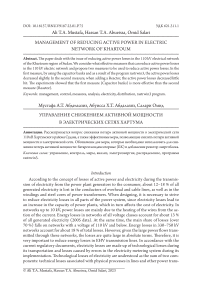Management of reducing active power in electric network of Khartoum
Автор: Mustafa Ali T.A., Abueissa Hassan T.A., Salari Omid
Рубрика: Управление сложными системами
Статья в выпуске: 1, 2023 года.
Бесплатный доступ
The paper deals with the issue of reducing active power losses in the 110 kV electrical network of the Khartoum region of Sudan. We consider what effective measures that can reduce active power losses in the 110 kV electric network and propose two measures to be used to reduce active power losses. In the first measure, by using the capacitor banks and as a result of the program rastrwin3, the active power losses decreased slightly. In the second measure, when adding a Reactor, the active power losses decreased little bit. The experiments showed that the first measure (Capacitor banks) is more effective than the second measure (Reactor).
Management, control, measures, analysis, electricity, distribution, rastrwin3 program
Короткий адрес: https://sciup.org/148326352
IDR: 148326352 | УДК: 621.311.1 | DOI: 10.18137/RNU.V9187.23.01.P.75
Текст научной статьи Management of reducing active power in electric network of Khartoum
According to the concept of losses of active power and electricity during the transmission of electricity from the power plant generators to the consumer, about 12–18 % of all generated electricity is lost in the conductors of overhead and cable lines, as well as in the windings and steel cores of power transformers. When designing, it is necessary to strive to reduce electricity losses in all parts of the power system, since electricity losses lead to an increase in the capacity of power plants, which in turn affects the cost of electricity. In networks up to 10 kV, power losses are mainly due to the heating of the wires from the action of the current. Energy losses in networks of all voltage classes account for about 13 % of all generated electricity (2005 data). At the same time, the main share of losses (over 70 %) falls on networks with a voltage of 110 kV and below. Energy losses in 330–750 kV networks account for about 18 % of total losses. However, given the large power flows transmitted through these networks, the losses are quite large in absolute terms. Therefore, it is very important to reduce energy losses in EHV transmission lines. In accordance with the current regulatory documents, electricity losses are made up of technological losses during its transportation and losses caused by errors in the electricity metering system during its implementation. Technological losses of electricity are understood as the sum of two components: technical losses associated with physical processes in lines and other power trans-
Мустафа Али Тариг Абдельазиз (Mustafa Ali Tarig Abdelaziz)
аспирант, Российский университет дружбы народов имени Патриса Лумумбы, Москва. Сфера научных интересов: сложные системы (модели, анализ и управление).
Абуисса Хассан Тариг Абдалазиз (Abueissa Hassan Tarig Abdalaziz)
аспирант, Российский университет дружбы народов имени Патриса Лумумбы, Москва. Сфера научных интересов: сложные системы (модели, анализ и управление).
Салари Омид (Salari Omid)
аспирант, Российский университет дружбы народов имени Патриса Лумумбы, Москва. Сфера научных интересов: сложные системы (модели, анализ и управление).
mission equipment, and losses due to the consumption of electricity for auxiliary needs of substations. Below we will consider only the technical losses of active power and energy in High tension lines transmissions. Their sum consists of losses for heating wires, losses for corona, losses in transformers, autotransformers, synchronous compensators and shunt reactors, leakage losses on insulators and ice melting. The given technical losses, in turn, can be divided into the following groups: load losses, depending on the load from the power transmission (losses for heating wires, load losses in transformers, autotransformers, synchronous compensators); conditionally constant losses, depending on the composition of the included equipment (losses in steel of transformers and autotransformers, losses in synchronous compensators and shunt reactors); losses depending on weather conditions, and therefore on the region in which the given power transmission takes place (losses for corona, for leakage through insulators, for melting ice). All these losses depend on the length of the line, the transmitted power, the composition of the equipment and other factors that are difficult to consider. Calculations of active power losses of energy should be carried out for each specific case, considering all its features. However, it should be noted that the main components of losses in power transmission are losses due to heating of wires.
Список литературы Management of reducing active power in electric network of Khartoum
- Ranganathan R., Briceno-Gramedia C.M. (2011) Sudan's Infrastructure: A Continental Perspective. Policy Research working paper; no. WPS 5815. URL: http://hdl.handle.net/10986/3578 (accessed 17.10.2022).
- Zarudsky G.K., Putyatin E.V., Ryzhov Yu.P., Shelukhina T.I. (1994) Dal'nie elektroperedachi v primerakh: Ucheb. posobie po kursu "Dal'nie elektroperedachi sverkhvysokogo napryazheniya" [Long-distance power transmission in examples: Textbook]. Moscow: Moscow Power Engineering Institute Publishing. 88 p. (In Russian).
- ZhelezkoYu.S., Sharov Yu.P., Shvedov G.V., Zarudsky G.K., Sipacheva O.V. (2011) Poteri elektroenergii v elektricheskikh setyakh: osnovnye svedeniya, raschet i normirovanie: ucheb. posobie [Losses of electricity in electrical networks]. Moscow: Moscow Power Engineering Institute Publishing. (In Russian).
- Ryzhov Yu.P. (2007) Dal'nie peredachi sverkhvysokogo napryazheniya [Long-distance transmission of ultra-high voltage: Textbook for university students]. Moscow: Moscow Power Engineering Institute Publishing. 488 p. (In Russian).


